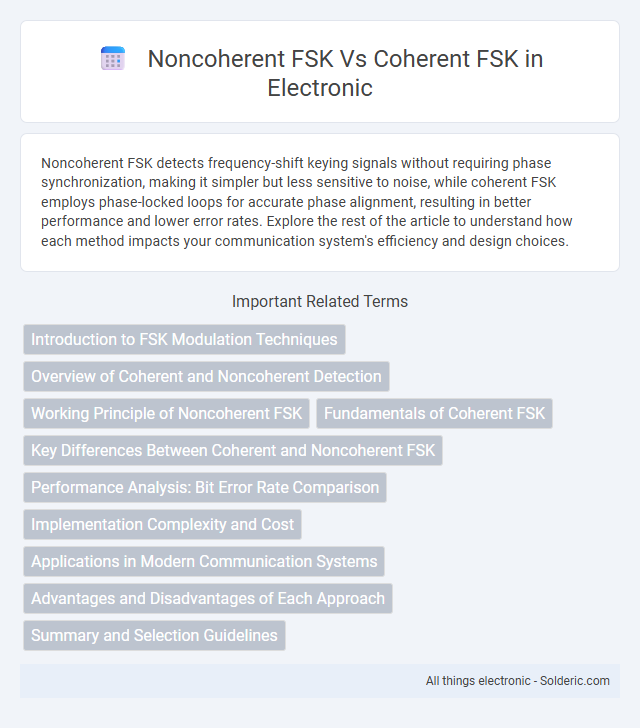Noncoherent FSK detects frequency-shift keying signals without requiring phase synchronization, making it simpler but less sensitive to noise, while coherent FSK employs phase-locked loops for accurate phase alignment, resulting in better performance and lower error rates. Explore the rest of the article to understand how each method impacts your communication system's efficiency and design choices.
Comparison Table
| Feature | Noncoherent FSK | Coherent FSK |
|---|---|---|
| Detection Method | Envelope detection, no phase reference | Phase-sensitive detection with a reference oscillator |
| Complexity | Low complexity, simpler receiver design | High complexity, requires phase synchronization |
| Performance (BER) | Higher bit error rate (BER) | Lower BER, better noise performance |
| Synchronization Requirement | No carrier phase synchronization required | Requires precise carrier phase synchronization |
| Power Efficiency | Less power efficient due to higher BER | More power efficient due to better detection |
| Applications | Simple, low-cost communication systems | High-performance and reliable communication systems |
Introduction to FSK Modulation Techniques
Frequency Shift Keying (FSK) modulation techniques include noncoherent and coherent detection, distinguished by their receiver architectures and sensitivity to phase information. Coherent FSK requires precise carrier phase synchronization for optimal demodulation, resulting in lower bit error rates in additive white Gaussian noise (AWGN) channels. Noncoherent FSK forgoes phase synchronization, simplifying receiver design and improving robustness in environments with rapid phase variations, albeit at the cost of higher error rates compared to coherent detection.
Overview of Coherent and Noncoherent Detection
Coherent FSK detection requires synchronization with the carrier signal's phase, enabling precise demodulation through correlators or matched filters, which results in lower bit error rates compared to noncoherent detection. Noncoherent FSK detection does not rely on phase synchronization, instead using energy detection or envelope detection to decode the signal, making it simpler but generally less efficient in noisy environments. Your choice between coherent and noncoherent FSK impacts receiver complexity, required synchronization accuracy, and overall communication reliability.
Working Principle of Noncoherent FSK
Noncoherent FSK operates by detecting frequency shifts without requiring phase synchronization between the transmitter and receiver, allowing simpler receiver design and lower complexity. The receiver employs energy detection or envelope detection methods to distinguish the transmitted frequencies, relying solely on the frequency difference rather than the signal phase. Your communication system benefits from noncoherent FSK when robustness to phase variations and reduced hardware complexity are essential.
Fundamentals of Coherent FSK
Coherent Frequency Shift Keying (FSK) relies on phase synchronization between the transmitter and receiver, enabling accurate detection of frequency changes by matching the received signal phase with a locally generated reference. This synchronization improves noise resistance and reduces bit error rates compared to noncoherent FSK, which detects frequency shifts without phase information. Understanding the fundamentals of coherent FSK is essential for optimizing digital communication systems where signal integrity and reliable data recovery are critical.
Key Differences Between Coherent and Noncoherent FSK
Coherent FSK employs phase synchronization between the transmitter and receiver, enabling optimal detection through correlation with a known reference signal, resulting in lower bit error rates compared to noncoherent FSK. Noncoherent FSK detects frequency variations without phase reference, simplifying receiver design but at the cost of higher susceptibility to noise and interference. The trade-off highlights coherent FSK's superior performance in stable environments versus noncoherent FSK's robustness in fast-varying or phase-uncertain channels.
Performance Analysis: Bit Error Rate Comparison
Noncoherent FSK exhibits higher bit error rates compared to coherent FSK under equivalent noise conditions due to the absence of phase synchronization, which reduces detection accuracy. Coherent FSK leverages precise carrier phase information, resulting in improved bit error rate performance, especially in low signal-to-noise ratio (SNR) environments. Analytical models show that the bit error rate of noncoherent FSK typically follows Q((E_b/N_0)), while coherent FSK achieves BER on the order of Q((2E_b/N_0)), indicating a significant advantage in energy efficiency.
Implementation Complexity and Cost
Noncoherent FSK systems feature simpler implementation and lower cost due to the absence of a need for phase synchronization, making them more suitable for low-power or budget-sensitive applications. Coherent FSK requires complex phase-locked loops and synchronization circuits, increasing both hardware complexity and overall cost. Your choice depends on balancing these factors against performance requirements, as coherent detection offers better noise immunity but at a higher implementation expense.
Applications in Modern Communication Systems
Noncoherent Frequency Shift Keying (FSK) is widely used in low-power and low-complexity communication systems such as RFID, wireless sensor networks, and simple IoT devices where phase synchronization is challenging. Coherent FSK, offering better bit error rate performance, is preferred in high-reliability applications like satellite communications, military radios, and advanced digital modems that require precise carrier phase tracking. Modern communication systems balance between these two by selecting noncoherent FSK for energy efficiency and coherent FSK for performance-critical data transmission.
Advantages and Disadvantages of Each Approach
Noncoherent FSK offers simpler receiver design and lower power consumption, making it suitable for low-complexity and energy-efficient applications, but suffers from higher bit error rates due to lack of phase information. Coherent FSK provides improved noise immunity and lower bit error rates by utilizing phase synchronization between transmitter and receiver, though it requires more complex circuitry and higher power consumption. The choice depends on trade-offs between system complexity, power usage, and performance requirements in communication systems.
Summary and Selection Guidelines
Noncoherent FSK eliminates the need for phase synchronization, making it simpler and more robust in noisy environments but with slightly lower spectral efficiency and higher bit error rates than coherent FSK. Coherent FSK requires precise phase synchronization, offering better performance and lower bit error rates in optimal conditions but at the cost of increased receiver complexity. Selection between these depends on trade-offs between complexity, power consumption, and performance requirements, with noncoherent FSK preferred for low-complexity or power-constrained applications and coherent FSK favored in high-performance communication systems.
noncoherent FSK vs coherent FSK Infographic

 solderic.com
solderic.com